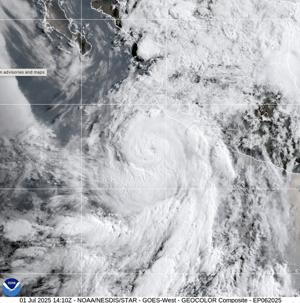MEXICO CITY (AP) — Hurricane Flossie intensified into a Category 2 cyclone on Tuesday off the Pacific coast of Mexico, with forecasters warning it could escalate into a major hurricane before weakening later this week. The National Hurricane Center reported that Flossie was packing maximum sustained winds of 110 mph (175 kph) and was delivering rain to parts of coastal Mexico.
The hurricane’s center was located 180 miles (285 kilometers) southwest of Manzanillo, Mexico. As of Tuesday afternoon, Flossie was teetering on the edge of becoming a Category 3 hurricane, a status achieved with sustained winds of at least 111 mph (180 kph). Forecasters predicted that Flossie could reach this threshold as early as Tuesday night or Wednesday morning.
Potential Impact on Mexico’s Pacific Coast
Flossie was moving northwest at 10 mph (17 kph), a trajectory expected to generally persist over the coming days. The system is anticipated to steer away from southwestern Mexico by Tuesday night. However, a tropical storm warning remains in effect from Punta San Telmo to Playa Perula, with rainfall totals potentially reaching up to 6 inches (15 centimeters) in certain areas.
According to meteorologists, the most significant threat posed by Flossie is heavy rainfall, which could lead to flash flooding in vulnerable regions. The hurricane center expects Flossie to commence a rapid weakening phase starting late Wednesday.
Historical Context and Expert Analysis
This development follows a series of intense weather events in the Pacific region. Historically, hurricanes such as Patricia in 2015, which reached Category 5 status, have demonstrated the potential for rapid intensification in this area. Experts suggest that warmer ocean temperatures, a consequence of climate change, may be contributing to the increasing frequency and intensity of such storms.
Dr. Maria Lopez, a climate scientist at the University of Mexico, commented,
“The Pacific coast of Mexico is no stranger to powerful hurricanes. However, the trend of stronger and more frequent storms is alarming and underscores the need for enhanced preparedness and adaptation strategies.”
Community Preparedness and Response
The announcement comes as local authorities in affected areas have begun implementing emergency protocols. Evacuation plans are being prepared, and shelters are being readied to accommodate those displaced by the storm. The Mexican government has urged residents in the path of the hurricane to remain vigilant and heed official advisories.
Meanwhile, humanitarian organizations are mobilizing resources to provide immediate relief and support to communities that may be impacted. The Red Cross has issued a statement emphasizing the importance of community cooperation and timely evacuation to ensure safety.
Looking Ahead: The Path of Flossie
As Flossie continues its northwestward journey, the focus will remain on monitoring its intensity and trajectory. While the current forecast suggests a weakening trend by late Wednesday, the situation remains fluid, and adjustments to predictions are possible.
For now, the priority for authorities and residents alike is to prepare for the worst while hoping for the best. The coming days will reveal whether Flossie fulfills its potential as a major hurricane or if it will diminish before causing significant damage.
In the aftermath of Flossie’s passage, attention will likely turn to the broader implications of such storms and the ongoing dialogue about climate resilience and adaptation in coastal regions.
About The Author
 Federal Scrutiny on Hollywood’s Diversity Quotas for Oscars Intensifies
Federal Scrutiny on Hollywood’s Diversity Quotas for Oscars Intensifies Air India CEO Unveils State-of-the-Art Training Facilities to CNN’s Richard Quest
Air India CEO Unveils State-of-the-Art Training Facilities to CNN’s Richard Quest Wilmington Teen Arrested for Gun Possession Sparks Community Concerns
Wilmington Teen Arrested for Gun Possession Sparks Community Concerns Justice Sought by Veterans in Texas Killing of Afghan Ally
Justice Sought by Veterans in Texas Killing of Afghan Ally Microschools Expand Beyond Their Initial Scope Amid Growing Demand
Microschools Expand Beyond Their Initial Scope Amid Growing Demand